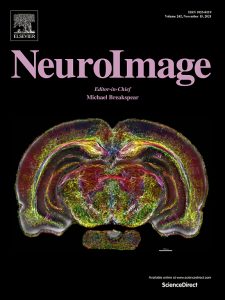Professor Zhen Yuan’s neuroimaging lab at the Centre for Cognition and Brain Science (CCBS)/Faculty of Health Sciences with the University of Macau (UM) has recently made a breakthrough in the investigations of language connectome and cross-primate comparison. For the first time, Prof. Yuan’s group successfully identified homologous mapping relationships between voxels within the human and macaque Broca’s area (Figure 1), revealed the inter-species, individual, and inter-hemispheric structural connectivity differences at the voxel level, and also inspected their inter-correlations (Figure 2). The work has now been published in the international top journal Neuroimage (2021 Impact Factor: 6.556, top 1 journal in neuroimaging). (https://doi.org/10.1016/j.neuroimage.2021.118583).
- Figure 1. Localization of homologous voxels between humans and macaques based on minimal structural connectivity differences.
- Figure 2: Inter-species, individual, and inter-hemispheric structural connectivity differences of voxels within the Broca’s area and their relationships
Macaque monkeys are classic translational animal models of humans. Cross-species quantitative comparisons of structural connectivity of the Broca’ area between the two species can help explore human-specific high-level cognitive functions (e.g., language), analyze the reliability of knowledge transfer, so as to use these animal models more efficiently. However, cortical borders of homologous areas across primates were defined ambiguously in the existing literature, which hinders the research progress in cross-primate comparison. Moreover, even though cross-species comparisons of single tracts (e.g., arcuate fiber) have produced interesting findings, the comparisons of whole-brain connections are still scarce.
Researchers used 23 pairs of homologous white matter bundles to characterize the structural connectivity patterns of voxels within the Broca’s area, and then localized the homologous voxels based on the similarity of connectivity patterns. Then, inter-species, individual, and inter-hemispheric connectivity differences as well as gray matter (GM) deformation were inspected. Partial correlation analyses were performed to inspect the relationships between the three types of connectivity variability after controlling the influence of GM deformation. According to the findings, the inter-species and inter-subject variabilities exhibited positive correlation in both two primates, yet negative relationship was identified between the inter-species variability and inter-hemispheric asymmetry. In particular, relatively higher inter-species and individual variabilities were detected in the anatomically defined pars triangularis, and relatively higher asymmetry was revealed in the anatomically defined pars opercularis. At the tract level, functional roles related to the dorsal stream in speech production show relatively higher species and hemispheric specializations, while those related to the ventral stream in speech comprehension were relatively conservative and bilaterally organized. These research results could advance our understanding into the structural connectivity modification within the Broca’ area, and also shed light upon the neural mechanisms of underlying human-specific high-level language functions.
The study was led by Prof. Zhen Yuan and the main participants were lab members of Yuan’s team: postdoc fellow Dr. Xiaoluan Xia (first author) and PhD candidate Mr. Fei Gao. This work was jointly supported by the Macau Science and Technology Development Fund (Ref No.: FDCT 0020/2019/AMJ & FDCT 0011/2018/A1), Macao SAR Government Higher Education Fund (Ref No.: CP-UMAC-2020-01), and RSKTO from the University of Macau.
Paper Information:
Xia, X., Gao, F., & Yuan, Z. (2021). Species and Individual Differences and Connectional Asymmetry of Broca’s Area in Humans and Macaques. NeuroImage, 118583.





